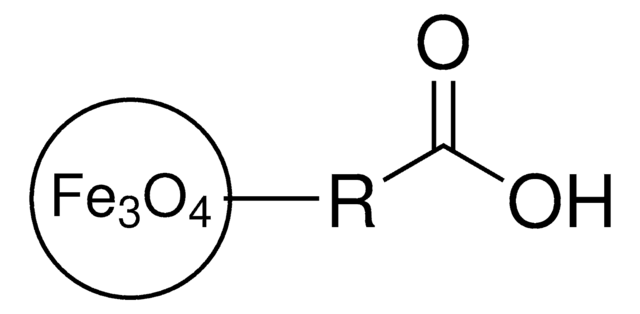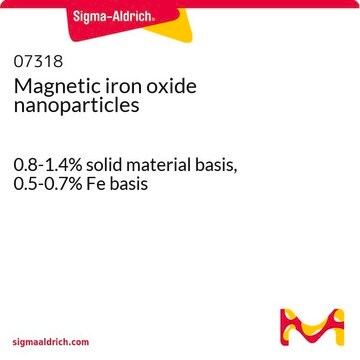725358
Iron oxide(II,III), magnetic nanoparticles solution
10 nm avg. part. size, 5 mg/mL in H2O
Sinonimo/i:
Magnetic iron oxide nanocrystals, Magnetite, Superparamagnetic iron oxide nanoparticles
About This Item
Prodotti consigliati
Forma fisica
dispersion
nanoparticles
Concentrazione
5 mg/mL in H2O
Magnetizzazione
>45 emu/g, at 4500Oe
Dimens. media delle particelle
10 nm
Dimensione particelle
9-11 nm (TEM)
Densità
1.00 g/mL at 25 °C
Stringa SMILE
O=[Fe].O=[Fe]O[Fe]=O
InChI
1S/3Fe.4O
SZVJSHCCFOBDDC-UHFFFAOYSA-N
Cerchi prodotti simili? Visita Guida al confronto tra prodotti
Categorie correlate
Descrizione generale
Applicazioni
- Optical resolution of ephedrine: A study explored the optical resolution of racemic ephedrine using various derivatives of tartaric acid, presenting a method that could refine the production of pharmaceutical-grade ephedrine hydrochloride (Bánhegyi et al., 2022).
- Stereoselective forensic analysis: Supercritical fluid chromatography coupled with tandem mass spectrometry was used to perform a stereoselective analysis of ephedrine and its isomers in seized methamphetamine samples, offering insights into forensic applications of ephedrine hydrochloride (Segawa et al., 2021).
- Chiral analysis of stimulants: A chiral high-performance liquid chromatography-tandem mass spectrometry method was applied to determine amphetamine-type stimulants, including ephedrine, in forensic samples, providing a tool for the precise separation and identification of chiral drugs (Schwelm et al., 2020).
Codice della classe di stoccaggio
12 - Non Combustible Liquids
Classe di pericolosità dell'acqua (WGK)
nwg
Punto d’infiammabilità (°F)
Not applicable
Punto d’infiammabilità (°C)
Not applicable
Certificati d'analisi (COA)
Cerca il Certificati d'analisi (COA) digitando il numero di lotto/batch corrispondente. I numeri di lotto o di batch sono stampati sull'etichetta dei prodotti dopo la parola ‘Lotto’ o ‘Batch’.
Possiedi già questo prodotto?
I documenti relativi ai prodotti acquistati recentemente sono disponibili nell’Archivio dei documenti.
I clienti hanno visto anche
Articoli
Explore DNA-functionalized nanoparticles in sensors for precise target analyte detection. Learn about types, synthesis, functionalization, and design optimization, with insights into challenges and prospects.
Professor Mitsuhiro Ebara provides insights on several types of smart nanofiber mesh systems that have been explored for different drug delivery purposes.
Professor Hui Mao explores the use of superparamagnetic iron oxide nanoparticles (INOPs) that offer an alternate contrast-enhancing mechanism.
Prof. Yadong Yin discusses various synthesis methods of magnetite nanocrystals and their applications in different fields.
Il team dei nostri ricercatori vanta grande esperienza in tutte le aree della ricerca quali Life Science, scienza dei materiali, sintesi chimica, cromatografia, discipline analitiche, ecc..
Contatta l'Assistenza Tecnica.


